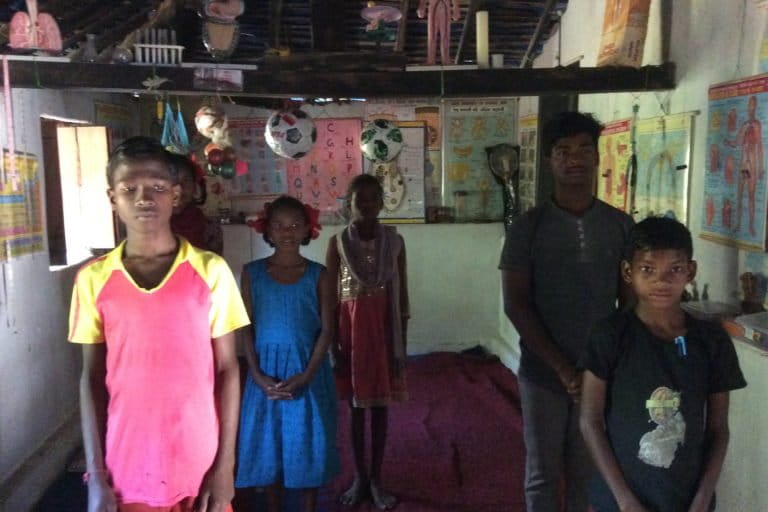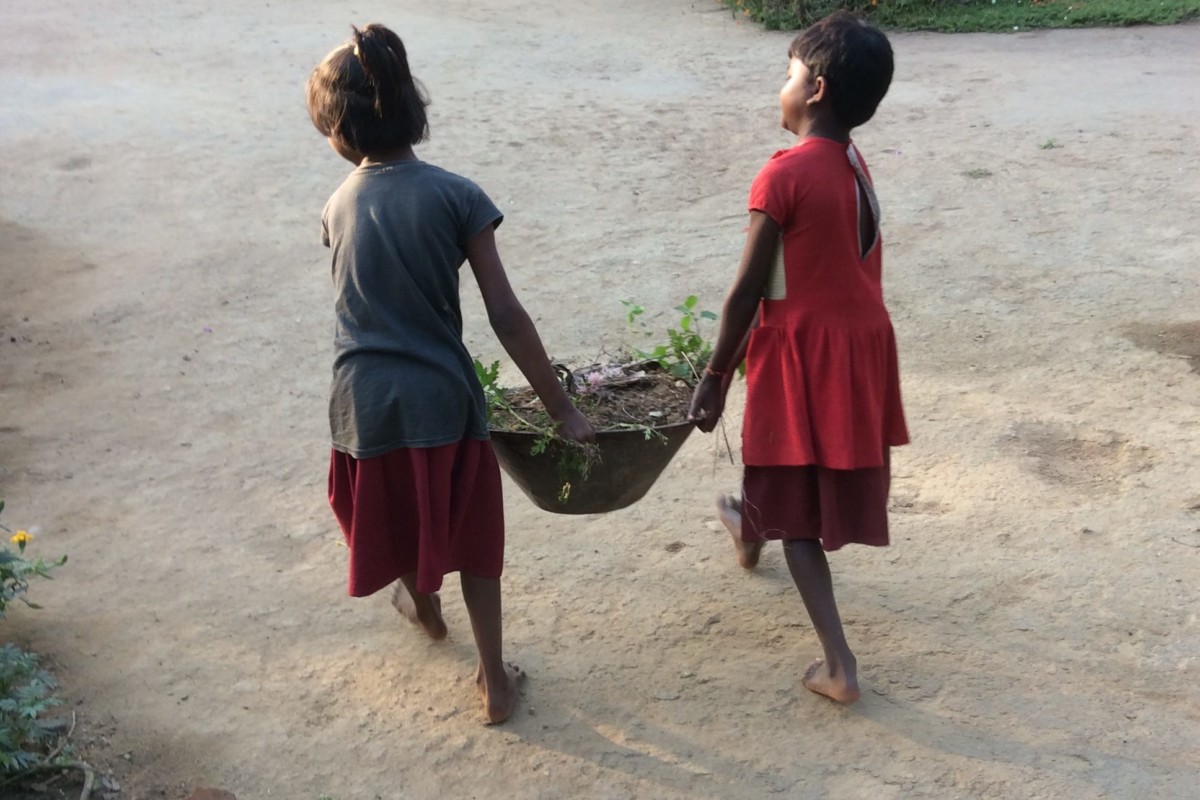- An alternative school in a tribal-dominated Jharkhand village is working to develop environmental consciousness among school students.
- Aayub School, a free school conceptualised by conservationist and India Youth Icon Award 2018 winner Pradhan Birua, is where school children head after their regular school hours.
- At this innovative tribal school, geography classes are held in the open and important concepts in physics are taught to students with the help of cycles and a tractor.
- Students of all ages participate in plantation activities and are taught about bird conservation, a significant lesson given that hunting birds is common in the region.
A hum of voices reciting “A for aluminium” and “B for boron” float through the air in a room of eager children. As the clock strikes three in the afternoon, a few older children, clutching books and notebooks, trickle into Pradhan Birua’s courtyard with hens clucking and pecking grains. In the backyard, gardening activities touch a feverish pitch. While some girls scoop dirty soil with shovels and place it in a large flower pot, others tie a blue nylon net around four bamboo poles encasing a tender banana plant.
Welcome to Aayub School in Pandrasali village of Jharkhand’s West Singhbhum district.
Here grassroots conservationist Pradhan Birua is leading a group of school students to bring about a positive change in society through youth participation.
An MBA degree holder, Birua, who belongs to the Ho tribe, worked for 10 years in Bengaluru before returning to his native village to fulfil his dream of spreading environmental consciousness among the youth.
“I found it easy to work with children. Adults did not show any interest in conservation activities. I feel that along with regular studies, children should be motivated to care for the environment,” Birua said. In Pandrasali, students of all ages participate in plantation activities. Common flowers found in most Indian villages dot the neat lanes and marigold clumps add to the beauty of Birua’s humble home. The children have also planted 500 palas (Butea monosperma) saplings this year on both sides of the Pandrasali-Putisia main road. In Jharkhand, palas has been accorded the status of the state flower.
Watering so many young trees is a daunting task. Birua and his team devised a novel method to overcome the hurdle. When students start for school in the morning, they carry two water bottles on their bicycles to water the trees. In this way, the trees are taken care of twice a day.
Though many trees have died, at present 296 exist. According to Birua, an important reason to choose palas was that stray cattle and goats stay away from it.

Besides planting trees, the children are also involved in the protection of different bird species found in the villages. Killing birds with bow and arrow or slingshot is a common practice among tribal communities here. Even children kill a lot of birds for fun or sport. According to a rough estimate provided by Birua, a child here kills 10 birds on an average a month.
For this reason, he felt the need to start the bird conservation drive as part of which children are taught the importance of avian species. Apart from Pandrasali, children from adjoining villages are also involved in the campaign.
“Killing of birds has reduced these days. We can change our community through the help of children. Birds scatter seeds, and hence, play an important role in germination. Right now, we are saving all kinds of birds,” Birua added.
A school with a difference
A boat-shaped greyish rock reclining on the ground serves as the bell at this school. To signify the start of each class, it is sounded with the help of a smaller rock.
The school runs from 4 am in the morning till 7 or 8 pm, all days of the week and is open to students from kindergarten to standard 10. During the major part of the day from approximately 10 am to 3 pm, the students of Aayub School attend their own schools, which have an affiliation to prescribed school education boards which this school does not.

Kindergarten teacher Nitima Bumij said that the faculty teach here voluntarily without pay and use innovative teaching methods. “We want these children to become successful in life. We take our own exams, apart from their regular exams at schools. There are 110 children, who regularly come to study here,” she added.
Seed necklaces crafted by the students are pinned on display boards on the walls.
Class 7 students cry ‘johar’, the traditional greeting of Jharkhand, on entering the classroom. The classroom is full of charts, samples and hanging footballs kept in nets.
Apart from the statues of tribal leader Birsa Munda, who led the war against the British, and B R Ambedkar, who was one of the architects of the Indian Constitution and fought against social inequity, a fossilised or petrified wood kept on the shelf catches the eye.
Gathered by Birua from Dhar, Madhya Pradesh, it is smooth to touch. “The children like to touch it when taught about fossils. They don’t spoil things kept here and never take home anything with them. This belongs to the Upper Cretaceous period,” Birua pointed out.

Kindergarten students recite numbers and associate them with the atomic numbers of chemical elements. In unison they say 1 for hydrogen, 2 for helium, 3 for lithium and this goes on till 20. “We have a different format for learning alphabets here. Unlike other schools where the alphabet A stands for apple and B for ball, we teach the names of oxygen, sulphur and platinum and other elements while teaching the 26 English alphabets. Children have to be encouraged to take an interest in science from a young age. This is a creative school. We have different samples to show them.”
“Our geography classes are held in the open. Sometimes, cycle rides are arranged for children, during which they go hunting for Stone Age settlements. We also teach Japanese here,” Bumij added.
Manisha Bodra, a class eight student, has been coming to Aayub for a month in addition to attending her regular school from 9 am to 2.30 pm.
A bright student, she feels bored at the government school she attends.
“Teachers explain well at Aayub School. In my school, we only study books, but never get to see things in real,” she said.
Raghunath Birua, who holds a diploma degree in mechanical engineering, teaches chemistry at the school. He explains the formation of ferrous oxide with the help of rusted cycle rings. According to him, this makes the students pay more attention than simply explaining the bookish theory that iron’s reaction with oxygen creates ferrous oxide.
Similarly, the concept of RPM (revolutions per minute) is explained with the help of a tractor. Speed and motion are also taught in this way. Birua also measures the radius of the tractor wheel and teaches friction with the help of bicycles. “Pedal force and brake help students to understand friction better. Centrifugal force is also taught like this,” he said. Regular cycling to and from school has taught class eight student Mahendra Gope these important concepts studied in physics.
Pradhan Birua received India’s Youth Icon Award 2018 for his achievements, but he says he has miles to go as far as spreading environmental consciousness is concerned. But right now, the wind of change is already blowing in this tribal hamlet of the Ho community.
According to Vineet Kumar, climate change expert at Delhi-based non-profit Centre for Science and Environment, youth and school students are extremely active as far as climate change is concerned.
“Youth and students do not have any hidden agenda. Without getting any kind of remuneration or salary, they are involved in a lot of activities. They are engaging themselves in various conservation works and plantation activities on a local level. School students are very sincere and many schools are involved in a lot of campaigns like plantation drives and water conservation activities,” Kumar said.
“Sometimes, many professionals in the climate change area often exaggerate their work or contribution. But the motive of students is pure and sincere. They are engaged in such projects because they are climate-conscious. The impact of climate change is more visible these days due to extensive media coverage. The impact of school children is real,” Kumar added.

Read more: Can environmental education save our planet?
